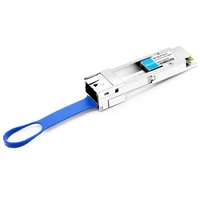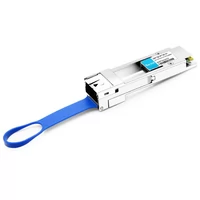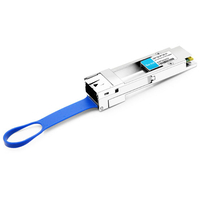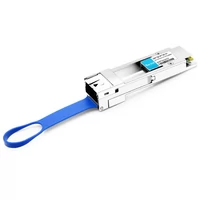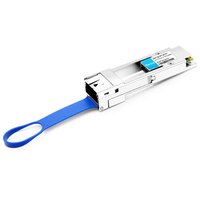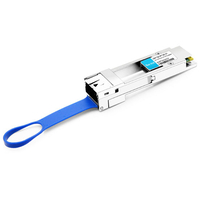The QSFP28 to SFP28 adapter is a necessary part of any contemporary data center network that helps create connections between devices with different shapes. The ability of the hardware to change becomes increasingly important as more and more information needs to be transmitted quickly (which means lower latency) through wider channels (higher bandwidth). This text intends to give the reader a complete comprehension of QSFP28 and SFP28 adapters, including their features, functions, and use cases for the SFP28 adapter converter module. Suppose you work in the IT industry and want your infrastructure optimized or are just fond of high technologies that may deepen your understanding. In that case, this article contains all the necessary knowledge that will allow you to use such things effectively within your networks.
Table of Contents
ToggleWhat Is a QSFP28 Adapter?
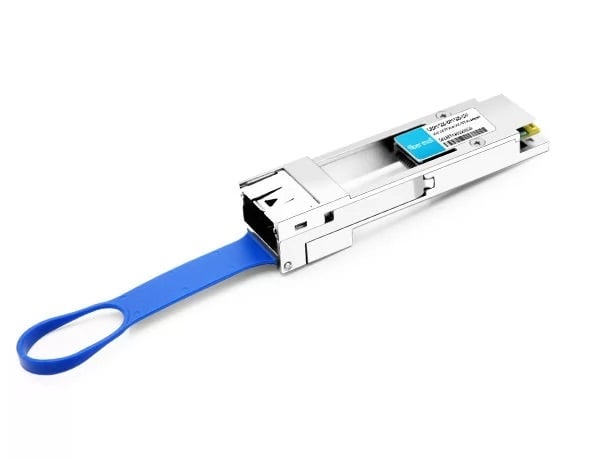
Understanding the QSFP28 Form Factor
A compact, high-density optical transceiver that supports data rates of up to 100 Gbps over fiber and 40 Gbps over copper cables is the QSFP28 (Quad Small Form-factor Pluggable 28). Each comprises four independent channels wherein everyone can transmit at 25 Gbps; this form factor effectively allows a total bandwidth of 100 Gbps within a single module. With its small size, the QSFP28 enables efficient utilization of space in data centers, which makes it perfect for cloud computing and enterprise networking environments powered by high-performance computing. Furthermore, QSFP28 connectors enhance versatility and scalability in network design by enabling interconnectivity with existing modules such as SFP28 or QSFP+.
Key Benefits of Using QSFP28 to SFP28 Adapters
The QSFP28 to SFP28 adapter has many advantages for network infrastructure. First, it helps integrate high-speed QSFP28 modules with existing SFP28 ports easily so that organizations can use what they have while moving towards higher bandwidths. This backward compatibility provides continuity without needing an entirely new setup.
Second, the device allows network admins to mix and match different transceiver types according to various bandwidth demands; this flexibility is vital when dealing with variable data traffic requirements.
Finally, IT experts who employ these adaptors can save on rack space and power consumption, thereby lowering their equipment costs per sq ft. They can also support more than 100 Gbe connections using a QSFP28. Such high-density configurations enable them to save physical resources such as cooling, which in turn allows for scaling up capacity in line with the growing demand for faster connectivity speeds across wide geographical areas or between continents.
Comparison with Other Transceiver Modules
When you compare QSFP28 modules to other transceiver solutions like SFP+ and SFP28, a few main differences show why QSFP28 is better. The first difference is that QSFP28s can handle much faster data rates, up to 100 Gbps. In contrast, SFP+s are limited by a maximum rate of only 10 Gbps, while SFP28s can transmit at most 25 Gbps. Because it has such high bandwidth capabilities, this module can easily meet all needs of modern data-intensive applications, making it preferable for any data center looking forward to future-proofing its infrastructure.
Another advantage of the QSFP28 over its competitors is space efficiency; four channels were integrated into one package instead of having just a single channel design like in both SFP+ and SFP28 modules. This means that less physical area will be needed, thus allowing for a greater number of connections within the same rack space. Moreover, unlike other SFP types, which only work with multi-mode or single-mode fibers depending on their specification sheet, this device supports both fibers, making it more flexible when used in various environments and distances. Thus, the combination of speed (100G), low latency (0.5ms), and efficient space utilization (4x1G) makes this gadget very strong in today’s networking setups.
How Does a QSFP28 to SFP28 Adapter Work?
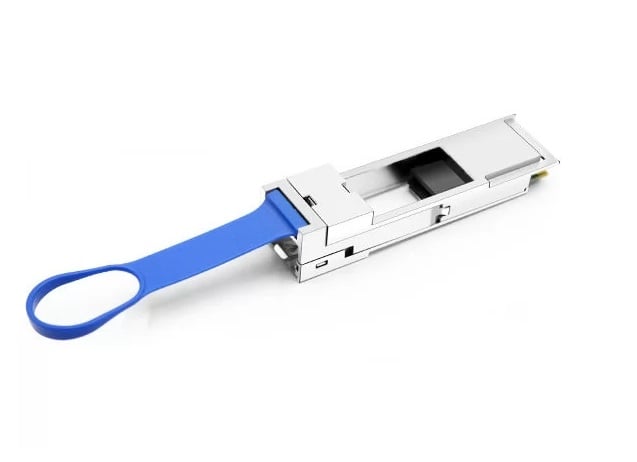
Technical Specifications and Functionality
A QSFP28 to SFP28 adapter is designed to make QSFP28 and SFP28 transceiver modules interoperable, using their capabilities to ensure that communication continues uninterrupted. While a single 25 Gbps lane limits the SFP28, the QSFP28 standard supports up to four lanes of 25 Gbps (100 Gbps total). The adapter operates using electrical and optical pass-throughs, which enables data transmission from a QSFP28 module to an SFP28 port so that multi-channel output is converted into a single-channel connection.
Generally, these adapters meet IEEE 802.3ba, 802.3bm, and 802.3cd standards for technical specifications so that they comply with required industry benchmarks for performance. For high-speed transmissions, care should be taken not only about signal loss but also electromagnetic interference (EMI); hence, good quality materials are used during construction since this can lead to corruption of information being sent or received. Furthermore, many QSFP28 to SFP28 adapters support different fiber types, including single mode and multimode fibers, making them more useful across various networking environments such as those based on 25Gbe SFPs.
QSFP28 and SFP28 Signal Conversion
The primary signal conversion between QSFP28 and SFP28 involves changing the electrical signals being sent over their physical interfaces. A QSFP28 module sends out four lanes of data, each having a capacity of 25 Gbps, while an SFP28 module uses only one lane at 25 Gbps. In this case, a QSFP28 to SFP28 adapter combines these multiple channels into one channel, which can then be fed into an SFP+ port.
This switch guarantees the electric signal remains intact and swift to incur negligible latency. It handles diverse electrical signaling standards and bandwidths needed by different devices operating on dissimilar signaling methods. Besides meticulously matching impedances, designing with minimum signal degradation in mind contributes to achieving the best possible performance during transmissions. Such flexibility comes in handy, especially when there are varying network traffic demands, thus enabling efficient resource allocation alongside load balancing within a system.
Common Use Cases in Data Centers
QSFP28 and SFP28 modules are frequently used in data centers to enhance connectivity and bandwidth management. Typical examples include:
- High-Density Networking: Data centers often utilize QSFP28 modules to allow for high-density networking configurations wherein several channels of data can be transmitted at once with minimum space requirements. This is especially significant in areas where much information needs to be passed through without necessarily taking up much physical space.
- Interconnecting Switches and Routers: A QSFP28 to SFP28 adapter makes it easy to interconnect switches with routers having different interface types. This versatility supports various architectural designs while enhancing effective communication across the network.
- Scaling Bandwidth for Cloud Services: Scalable bandwidth has become required as more establishments opt for cloud-based solutions. Quick scalability is made possible by QSFP28 modules, which provide high-speed connections capable of meeting the demands posed by cloud services, thereby ensuring efficient and reliable data transfer under varying workloads.
These applications reveal how important advanced transceiver technology is in meeting the changing demands faced by modern data centers and their insatiable appetite for larger volumes of information.
Installation and Configuration
Step-by-Step Guide to Installing QSFP28 Adapters
To guarantee the best performance and compatibility, the installation of QSFP28 adapters must be performed carefully, paying attention to every detail. Here is a step-by-step guide on how to do it:
- Prepare Your Equipment: Before starting the process, you should have all the necessary tools—an anti-static wrist strap, screwdriver, and QSFP28 adapters. Make sure that your server or switch is powered off and disconnected from electricity to prevent any possible damage.
- Ground Yourself: To prevent electrostatic discharge (ESD), put on an anti-static wrist strap and connect it to a grounded object. This will help you protect delicate electronic components from ESD.
- Find The PCIe Slot/Network Port: Locate the appropriate PCIe slot on your network device that corresponds with the QSFP28 adapter being installed. Check whether this port matches the adapter you will use and note its insertion orientation.
- Insert Adapter: Align the QSFP28 adapter with the slot and gently push it inside until fully seated into place. Do not apply excessive force while doing so, as the wrong alignment may damage the connector.
- Fixate Adapter: If needed, secure Qsfp28 Adapters through screws or latches so that they do not move during regular operation; this is important for stable connection continuity.
- Connect Fiber Cables: Attach the fiber optic cables to the QSFP28 adapter and ensure the cable is secure on a QSFP28 port. Confirming the connections are safe and that cables run rightly so as not to strain the connectors physically.
- Power on the Device: Plug in the power supply and switch on either the server or switch connected to lane 1 of QSFP28. Throughout this time, watch out for error messages or any indicators that something went wrong during installation.
- Configure the Network Settings: Once powered up, access the network management interface to configure settings for this new qsfp28 adapter. Update the firmware and check if it is recognized by the system while also operating at optimum performance levels.
- Testing the Connection: Perform a network performance test to verify that data transfer rates are reaching expectations. Monitor traffic to validate whether or not an adapter is working properly and efficiently without disruptions.
Following these step-by-step instructions will enable users to install qsfp28 adapters effectively, thereby improving their network infrastructure and ensuring reliable performance.
Configuring Your Network for Optimized Performance
Configuring your network for optimal performance involves a few important steps. The first is to ensure your network architecture is scalable and robust enough to allow for future growth without causing significant disruptions. Also, it is necessary to segment networks into subnets, which will help increase performance and security; this can be done through virtual local area networks (VLANs). Besides, Quality of Service (QoS) settings need configuring so as to prioritize bandwidth towards critical applications thus making sure that required resources are given for their optimum operation.
Moreover, regular monitoring and analysis of network traffic by using tools such as Network Performance Monitors (NPM) can help identify bottlenecks and areas where improvements should be made. Redundancy should be implemented through multiple connections and failover systems, which increases reliability while reducing downtime, especially in configurations involving 100Gbe QSFP28. Last but not least, firmware updates and periodic changes in network device configurations are vital for security maintenance as manufacturers often release patches that fix bugs or improve efficiency. Therefore, higher levels of performance can be achieved within networks when these strategies are adopted along with enhanced reliability.
Troubleshooting Common Issues
Knowing how to solve network problems is crucial for maintaining optimal performance and reliability. Some common problems include connectivity issues, intermittent disconnections, and slow network speeds.
- Finding out what the problem is with Connectivity: Verify that all cables are properly plugged in and not damaged by verifying physical connections. Use ping commands to check whether devices within the network can communicate with each other and look for any disparities in the network configurations that may arise due to IP address conflicts.
- Random Disconnections: Many frequent disconnections can be attributed to firmware or driver-related problems with the QSFP28 TO 25G SFP28 Adapter; hence, it is important that the latest firmware updates are installed on all networking devices such as routers, switches, etc. Moreover, external factors like electronic interference or weak signal strength might affect the performance of the optic transceiver module.
- Slow Speeds of Network: When users experience lower than anticipated speeds conducting bandwidth tests at various times will help discover traffic patterns. QoS settings should be implemented so as to prioritize necessary traffic while further examination by use of network performance monitoring tools could reveal specific devices or applications consuming too much.
By following these troubleshooting steps, users can quickly identify and fix typical network issues, thereby improving overall system performance and user satisfaction.
Performance and Compatibility
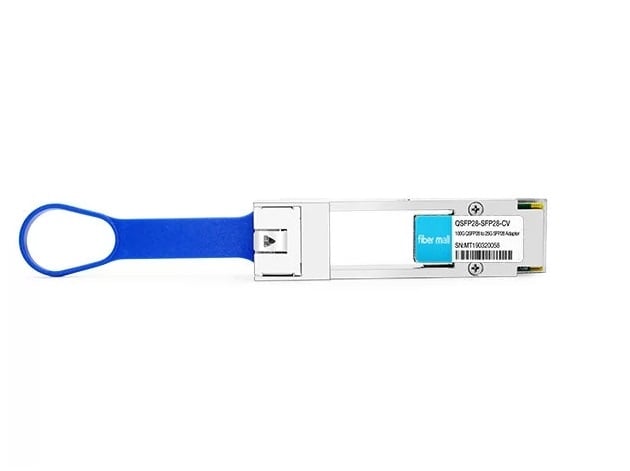
Ensuring Compatibility with Different Modules
To ensure seamless integration and performance, compatibility with different modules must be viewed many things. Some of the considerations are
- Specifications and Standards: Every networking hardware module, especially the optical transceiver module, must follow industry standards like IEEE. You should also look at protocol support (e.g., TCP/IP, SNMP) stated in the specifications to ensure good communication between modules.
- Firmware and Software Versions: Compatibility problems often occur due to versions that do not match either firmware or software. Ensure that you update them regularly, as this will help you check for compatibility improvements or known issues through the manufacturer’s release notes.
- Interoperability Testing: It is important to conduct extensive interoperability tests under various conditions where they are supposed to work together correctly according to their design (modules). Simulated environments can be used for performance evaluation so that these modules respond well to normal operations even under error conditions, particularly when connected with lane 1 of QSFP28.
By following these steps of reviewing for compatibility, integration risks can be reduced, thereby leading to a stronger network architecture that comprises QSFP28 to 25G SFP28 adapter.
Performance Metrics: 100G QSFP28 to 25G SFP28
The move from 100G QSFP28 to 25G SFP28 involves several performance metrics and considerations for network architecture. A QSFP28 interface can achieve data rates of up to 100 Gbps through four channels of 25 Gbps each, while an SFP28 supports a single channel at 25 Gbps. Some important measures to consider in this transition are:
- Throughput Efficiency: This is the measure of how well the link performs under real-world conditions; with their design focused on high-bandwidth applications, 100G QSFP28 modules may be less flexible than 25G SFP28, which can cater to edge networks.
- Latency: The latency between these connections will depend on the network design as well as the devices used. Typically, SFP28 has a simpler architecture that could lead to lower latencies.
- Power Consumption: Comparatively speaking, QSFP28 modules demand more power than their counterparts (SFP28s). This can have significant cost implications, particularly for large-scale deployments where many modules might be needed concurrently.
In conclusion, one should choose either 100G QSFP28 or 25G SFP based on specific network performance requirements, such as bandwidth needs, latency concerns, or power-saving aims. Considering these kinds of performances would help create better system architecture designs.
Customer Reviews and Experiences
When reviewing customer feedback and experiences on the shift from 100G QSFP28 to 25G SFP28, it is found that a number of top online resources have some things in common.
- Satisfaction with Performance: Many users have expressed their satisfaction with the performance increase after deploying 25G SFP28 where there are stable bandwidth requirements. For edge networking, people appreciate the general operational efficiency enhancement brought about by the flexibility of modules, as said earlier under this subtopic.
- Cost-effectiveness: Multiple reviews point out lower operating costs associated with SFP28, especially power consumption reduction and total installation expense savings. Some customers may invest heavily in QSFP28 at first for high performance, but they state that over time, large-scale environments cannot ignore savings realized through module types like this one.
- Problems with Integration: Though most people see this change positively, they still face a few integration problems. Complexities in technology when interfacing existing infrastructure with these modules can make it difficult to set them up initially hence calling for thorough compatibility checks so that everything runs smoothly.
These findings indicate an increasing effort to optimize network architecture based on specific performance requirements and financial constraints through appropriate component selection.
Types of QSFP28 to SFP28 Adapters
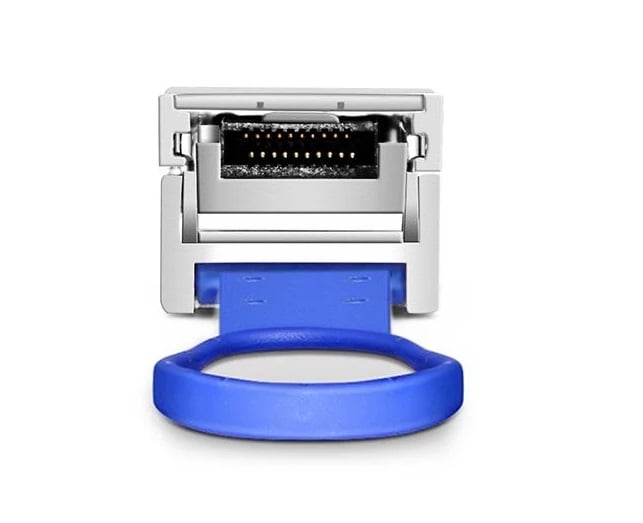
Overview of QSA Adapters
The Quality SFP28 Adapters (QSA) are essential for connecting 100G QSFP28 and 25G SFP28 devices. They allow network engineers to use their existing QSFP28 ports as 25G SFP28 connections, optimizing their resources while minimizing capex on equipment upgrades. The QSAs work by electrically replicating signals from a QSFP28 host to an SFP28 module, ensuring compatibility and maintaining data integrity.
In addition, best practices state that using QSA adapters can make networks more flexible because it enables them to support different bandwidth needs without changing everything about their setup. They are also much smaller compared with other types of converters which saves space in network racks. Even though performance may be slightly lower than with direct SFP28 deployments, this type of adapter offers businesses a practical way of improving their networking capabilities step by step and without causing too many disruptions. Simply put, these devices represent a smart approach when designing networks since they allow for smooth transitions between various speed interfaces while still serving operational goals.
Direct Attach and Active Optical Cable Options
Direct Attach Copper (DAC) cables and Active Optical Cables (AOCs) are two popular solutions for connecting QSFP28 and SFP28 devices. Cost-effective DAC cables use parallel copper twinax cables with built-in transceivers for short-distance connections, typically up to 7 meters. The power consumption is low and has lower latency, which is appreciated in high-density data center environments.
On the other hand, AOCs use optical fibers and have a transceiver at both ends; this allows them to cover longer distances ranging from 100 meters onwards, depending on the cable type and wavelength used. They are light in weight and flexible making them easy to install in setups where space may be limited or there is complexity involved. Although each cable type has its own advantages; selection between these options should largely depend on distance requirement within network infrastructure as well as bandwidth need plus overall cost implications. Network engineers can thus evaluate such aspects appropriately so that they can choose what suits their infrastructure goals best while considering performance targets too.
Adapter Module Variants
Adapter modules help make networking devices more flexible and compatible. These modules come in different form factors, such as SFP, SFP+, QSFP, and QSFP28, which are used for different applications and performance levels.
- Small Form-factor Pluggable (SFP): Frequently employed when there is the need for Gigabit Ethernet or Fibre Channel solutions over short distances within a network. It allows speed up to 1 Gbps.
- Enhanced Small Form-factor Pluggable (SFP+): This variant supports a 10 Gbps rate and is mainly used in data centers or enterprise networks where various applications require higher bandwidths.
- Quad Small Form-factor Pluggable (QSFP): Used for high-performance computing because of its ability to provide greater data rates at 40 Gbps which is necessary for transferring large amounts of information between clouds.
- QSFP28: This module can achieve speeds up to 100 Gbps, making it possible to design 100 Gigabit Ethernet networks that have never been seen before.
Apart from power consumption levels, distance limitations, as well as specific use scenarios, must be considered before choosing an adapter module since they allow organizations to customize network designs effectively.
Reference Sources
Frequently Asked Questions (FAQs)
Q: What is a QSFP28 to SFP28 adapter?
A: A QSFP28 to SFP28 adapter is a module that converts between a QSFP28 port and an SFP28 transceiver or cable, enabling 100G to 25G ethernet connectivity.
Q: How does a QSFP28 to SFP28 converter module work?
A: It works by taking the 100G signal from the QSFP port and splitting it into four separate 25G signals. Each of these signals is then sent via different SFP ports, which allows for efficient data transfer and networking flexibility.
Q: What types of cables can be used with a QSFP28 to SFP28 adapter?
A: For this kind of adapter, you could use optical transceivers or direct-attached copper cables, depending on your networking needs and the distance the data has to travel.
Q: Is the QSFP28 to SFP28 converter module compatible with Cisco equipment?
A: Yes, they are compatible with Cisco equipment and with other manufacturers’ devices that follow MSA (Multi-Source Agreement) standards.
Q: What is the difference between QSFP28 and SFP28 ports?
A: The main difference is that one supports 100Gbps Ethernet connectivity while another only supports up to 25Gbps. Additionally, it can be split into four channels, each running at 25Gbps. Therefore, such conversion allows for a more flexible network design and better cable utilization for a QS FP port.
Q: Can a QSFP28 to SFP28 adapter be used for copper and optical?
A: Yes, it can work with direct-attached copper cables and optical modules, which means it is suitable for different network environments, including those with SFP28 adapter converter modules.
Q: In QSFP28 to SFP28 adapters, what does 4 x 25G mean?
A: Here, 4 x 25G refers to dividing the 100Gbps signal from a QSFP28 port into four separate channels of 25Gbps each, each of which can be connected to an SFP28 receptacle.
Q: How does channel mapping work in a QSFP28 to SFP28 converter module?
A: It maps each 25G channel of the SFP28 receptacle into the corresponding lane of the QSFP28 port, ensuring proper data transfer and connectivity.
Q: What are the advantages of using the QSFP28 to SFP28 adapter?
A: The benefits include more flexibility in network setup, reusing existing SFP+ transceivers or cables, cost savings by upgrading components rather than whole systems, and simplified network infrastructure management.
Q: What is an SFP28 25GBASE-SR transceiver?
A: An optical module designed for short-range data transmission at 25 Gbps, typically over multimode fiber cables compatible with the adapter’s SFP+ port.
Related Products:
-
 Arista Networks CVR-QSFP28-SFP28 Compatible 100G QSFP28 to 25G SFP28 Adapter Converter Module
$55.00
Arista Networks CVR-QSFP28-SFP28 Compatible 100G QSFP28 to 25G SFP28 Adapter Converter Module
$55.00
-
 Cisco CVR-QSFP28-SFP28 Compatible 100G QSFP28 to 25G SFP28 Adapter Converter Module
$55.00
Cisco CVR-QSFP28-SFP28 Compatible 100G QSFP28 to 25G SFP28 Adapter Converter Module
$55.00
-
 QSFP28-SFP28-CV 100G QSFP28 to 25G SFP28 Adapter Converter Module
$55.00
QSFP28-SFP28-CV 100G QSFP28 to 25G SFP28 Adapter Converter Module
$55.00
-
 Dell CVR-QSFP28-SFP28 Compatible 100G QSFP28 to 25G SFP28 Adapter Converter Module
$55.00
Dell CVR-QSFP28-SFP28 Compatible 100G QSFP28 to 25G SFP28 Adapter Converter Module
$55.00
-
 Juniper Networks CVR-QSFP28-SFP28 Compatible 100G QSFP28 to 25G SFP28 Adapter Converter Module
$55.00
Juniper Networks CVR-QSFP28-SFP28 Compatible 100G QSFP28 to 25G SFP28 Adapter Converter Module
$55.00
-
 NVIDIA(Mellanox) MAM1Q00A-QSA28 Compatible 100G QSFP28 to 25G SFP28 Adapter Converter Module
$60.00
NVIDIA(Mellanox) MAM1Q00A-QSA28 Compatible 100G QSFP28 to 25G SFP28 Adapter Converter Module
$60.00

